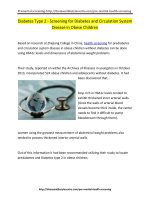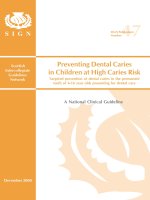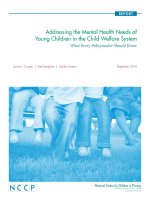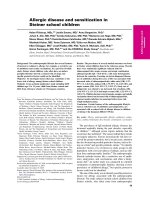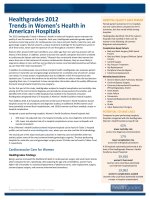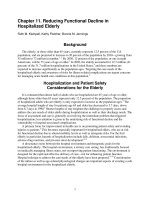Preventing Lead Poisoning in Young Children pptx
Bạn đang xem bản rút gọn của tài liệu. Xem và tải ngay bản đầy đủ của tài liệu tại đây (2.09 MB, 137 trang )
A STATEMENT BY THE
CENTERS FOR DISEASE CONTROL AND PREVENTION
AUGUST 2005
Preventing
Lead
Poisoning
in
Young
Children
U.S. DEPARTMENT OF HEALTH AND HUMAN SERVICES
Centers for Disease Control and Prevention
Preventing
Lead Poisoning
in
Young Children
A Statement by the Centers for Disease Control and Prevention
August 2005
Centers for Disease Control and Prevention
Julie L. Gerberding, MD, MPH, Director
National Center for Environmental Health
Tom Sinks, PhD, Acting Director
Division of Emergency and Environmental Health Services
Jim Rabb, Acting Director
Lead Poisoning Prevention Branch
Mary Jean Brown, ScD, RN, Chief
U.S. Department of Health
and Human Services, Public Health Service
Suggested reference:
Centers for Disease Control and Prevention. Preventing Lead Poisoning in Young Children. Atlanta:
CDC; 2005.
Table of Contents
Advisory Committee on Childhood Lead Poisoning Prevention
Members, Ex-Officio and Liaison Representatives v
Preface ix
Introduction 1
Preventing Childhood Lead Poisoning in the United States 1
CDC’s Blood Lead Level of Concern 2
Responding to Data on Adverse Health Effects at Blood Lead
Levels <10 µg/dL from a Public Health Perspective 3
Recommendations 5
Conclusion 8
References 8
Appendix: A Review of Evidence of Adverse Health Effects
Associated with Blood Lead Levels <10 µg/dL in Children 11
Appendix Table of Contents i
Summary iii
Work Group Members vi
Abbreviations and Acronyms vii
Background 1
Review Methods 4
Results 8
Discussion 13
Overall Conclusions 29
Research Needs 32
Appendix A: Literature Review and Classification Update A-1
Appendix B: Critique of NHANES III Data by Stone, et al. (2003) B-1
References R-1
iii
Advisory Committee on Childhood Lead Poisoning
Prevention Members, Ex-Officio
and Liaison Representatives
CHAIR
Carla Campbell, MD, MS
The Children’s Hospital of Philadelphia
Philadelphia, Pennsylvania
EXECUTIVE SECRETARY
Mary Jean Brown, ScD, RN
Chief, Lead Poisoning Prevention
Branch
National Center for Environmental
Health
Centers for Disease Control
and Prevention
Atlanta, Georgia
MEMBERS
W
illiam Banner, Jr. MD, PhD
The Children’s Hospital at Saint Francis
Tulsa, Oklahoma
Helen J. Binns, MD, MPH*
Children’s Memorial Hospital
Chicago, Illinois
Walter S. Handy, Jr., PhD
Cincinnati Health Department
Cincinnati, Ohio
Ing Kang Ho, PhD
University of Mississippi Medical
Center
Jackson, Mississippi
Jessica Leighton, PhD, MPH
New York City Department of Health
& Mental Hygiene
New York, New York
Valarie Johnson
Urban Parent to Parent
Rochester, New
York
Tracey Lynn, DVM, MPH†
Alaska Department of Health
and Social Services
Anchorage, Alaska
Sally Odle
SafeHomes, Inc.
Waterbury
, Connecticut
George G. Rhoads, MD, MPH
University of Medicine and Dentistry
of New Jersey
Piscataway, New Jersey
Catherine M. Slota-Varma, MD
Pediatrician
Milwaukee, Wisconsin
W
ayne R. Snodgrass, PhD, MD
University of Texas Medical Branch
Galveston, Texas
Kevin U. Stephens, Sr., MD, JD
New Orleans Department of Health
New Orleans, LA
Kimberly M. Thompson, ScD
Harvard School of Public Health
Boston, Massachusetts
*ACCLPP member until May 2004
†ACCLPP member until October 2004
v
EX-OFFICIO
Centers for Disease Control
and Prevention
Robert J. Roscoe, MS
Centers for Medicare and
Medicaid Services
Jerry Zelinger, MD
National Institute for Occupational
Safety and Health Sciences
Walter Rogan, MD
U.S. Agency for International
Development
John Borrazzo, PhD
U.S. Consumer Product Safety
Commission
Lori Saltzman
U.S. Department of Housing and
Urban Development
David E. Jacobs, Ph.D., CIH
U.S. Environmental Protection Agency
Jacqueline E. Mosby
, MPH
U.S. Food and Drug Administration
Michael P. Bolger, PhD
LIAISON REPRESENTATIVES
Alliance for Healthy Homes
Anne M. Guthrie, MPH
American Academy of
Nurse Practitioners
Jan T
owers, PhD
American Academy of Pediatrics
J. Routt Reigart, II, MD (1997-2004)
American Association of Poison
Control Centers
George C. Rodgers, Jr
., MD, PhD
American Industrial Hygiene Association
Steve M. Hays, CIH, PE
American Public Health Association
Ben Gitterman, MD
Association of Public Health Laboratories
Henry Bradford, Jr
., PhD
Council of State and Territorial
Epidemiologists
Ezatollah Keyvan-Larijani, MD, DrPH
National Center for Healthy Housing
Pat McLaine, RN, MPH
REVIEW OF EVIDENCE FOR
EFFECTS
AT BLLS <10 µg/dL WORK
GROUP
Michael L. Weitzman, MD
Work Group Chair
Center for Child Health Research
University of Rochester
Tom Matte, MD, MPH
National Center for
Environmental Health
Centers for Disease Control
and Prevention
David Homa, PhD
National Center for
Environmental Health
Centers for Disease Control
and Prevention
Jessica Sanford, PhD
Battelle Memorial Institute
vi
Alan Pate
Battelle Memorial Institute
Joel Schwartz, Ph.D.
Department of Environmental Health
Harvard School of Public Health
David Bellinger, PhD,
Neuroepidemiology Unit Children’s
Hospital
Harvard Medical School
David A. Savitz, PhD
Department of Epidemiology
University of North Carolina School
of Public Health
Carla Campbell, MD, MS
Division of General Pediatrics
The Children’s Hospital of Philadelphia
Patrick J. Parsons, PhD
Wadsworth Center for Laboratories
and Research
New York State Department of Health
Betsy Lozoff, MD
Center for Human Growth and
Development
University of Michigan
Kimberly Thompson, ScD
Department of Health Policy
and Management
Harvard School of Public Health
Birt Harvey, MD
Pediatrician
Palo
Alto, California
vii
Preface
This is the fifth revision of Preventing Lead Poisoning in Young Children by
the Centers for Disease Control and Prevention (CDC). As with the previous
statements, the recommendations presented here are based on scientific evidence
and practical considerations. This revision accompanies a companion document,
A Review of Evidence of Adverse Health Effects Associated with Blood Lead Levels
<10 µg/dL in Children, developed by Advisory Committee on Lead Poisoning
Prevention which reviews the scientific evidence for adverse effects in children at
blood lead levels below 10 µg/dL.
The data demonstrating that no “safe” threshold for blood lead levels (BLLs)
in young children has been identified highlights the importance of preventing
childhood exposures to lead. It confirms the need for a systematic and society wide
effort to control or eliminate lead hazards in children’s environments before they
are exposed. This emphasis on primary prevention, although not entirely new, is
highlighted here and is clearly the foremost action supported by the data presented
in A Review of Evidence of Adverse Health Effects Associated with Blood Lead Levels
<10 µg/dL in Children.
Although there is evidence of adverse health effects in children with blood lead
levels below 10 µg/dL, CDC has not changed its level of concern, which remains
at levels >10 µg/dL. We believe it critical to focus available resources where the
potential adverse effects remain the greatest. If no threshold level exists for adverse
health effects, setting a new BLL of concern somewhere below 10 µg/dL would
be based on an arbitrary decision. In addition, the feasibility and effectiveness
of individual interventions to further reduce BLLs below 10 µg/dL has not been
demonstrated.
CDC is conducting several activities to focus efforts on preventing lead exposures
to children. First, beginning in 2003, CDC required state and local health
departments receiving funding for lead poisoning prevention activities to develop
and implement strategic childhood lead poisoning elimination plans. Second, CDC
and its federal partners, the Department of Housing and Urban Development and
the Environmental Protection Agency, launched new initiatives to control lead-
based paint hazards in the highest risk housing, addressing where successive cases
of lead poisoning have been identified. Third, CDC and other federal agencies are
developing a systematic and coordinated response to identify and eliminate non-
paint sources of exposure (e.g., lead jewelry, food and traditional medicines, and
cosmetics).
CDC continues to monitor progress toward the Healthy People 2010 objective of
eliminating elevated BLLs in children at the national level through the National
Health and Nutritional Examination Survey and at the state and local levels
through the blood lead surveillance system. These complementary data provide
ix
essential information for the rational distribution of resources to communities with
the highest risk for lead exposure.
I wish to thank both current and former members of the Advisory Committee on
Childhood Lead Poisoning Prevention and consultants who developed the docu-
ments in this statement and acknowledge their contribution to the health of the
nation’s children. The Committee considered a number of controversial issues,
examined the existing data and reviewed the report of the work group. This 2005
statement represents agreement of 12 of the 13 Advisory Committee members serv-
ing on the committee as of October 19-20, 2004.
Thomas Sinks, Ph.D.
Acting Director
National Center for Environmental Health/Agency for Toxic Substances
and Disease Registry
x
INTRODUCTION
The U.S. Department of Health and Human Services has established an ambitious
goal of eliminating elevated blood lead levels (BLLs) in children by 2010, a
qualitatively different goal from earlier goals that focused on reducing the BLL
considered toxic by various target amounts.
1
Recent research on lead’s health effects
at low levels, which suggests societal benefits from preventing even low level lead
exposure in childhood, underscores the importance of this public health goal.
This revised statement describes the public health implications of research findings
regarding adverse health effects at low BLLs summarized in the accompanying
review, and focuses on the Centers for Disease Control and Prevention’s blood lead
“level of concern.” This statement aims to guide public health practice and policy
development and review necessary steps to ensure progress toward meeting the
2010 goal.
PREVENTING CHILDHOOD LEAD POISONING IN THE UNITED STATES
The reduction of BLLs in the United States during 1970-1999, primarily because of
implementation of federal and state regulations to control lead exposure, was one
of the most signifi
cant public health successes of the last half of the 20th century.
2
Nonetheless, some populations and geographic areas remain at disproportionately
high risk for lead exposure.
3-5
Specific strategies that target screening to high-risk
children are essential to identify children with BLLs >10 µg/dL. Once identified,
children with elevated BLLs should receive follow-up services as recommended in
Managing Elevated Blood Lead Levels Among Young Children.
6
However, preventing elevated BLLs is the preferred course of action. A compelling
body of evidence points to the limited effectiveness of waiting until children’s
BLLs are elevated before intervening with medical treatments, environmental
remediation, or parental education.
7-12
Data indicate that in many cases it takes
years to reduce children’s BLLs once levels are elevated whether the initial blood
lead elevation is very high or moderate.
13-15
The most common high-dose sources of
lead exposure for U. S. children are lead-based paint and lead-contaminated house
dust and soil. Recent studies have identified methods to reduce common household
lead hazards safely.
16
Thus, a multitiered approach that includes secondary
prevention through case identification and management of elevated BLLs is needed
to eliminate childhood lead poisoning. However, because no level of lead in a child’s
blood can be specified as safe, primary prevention must serve as the foundation of
the effort.
1
CDC’S BLOOD LEAD LEVEL OF CONCERN
The adverse health effects associated with elevated BLLs have been widely studied
and documented. Previously, CDC responded to the accumulated evidence of
adverse effects associated with lead exposures by lowering the BLL of concern.
Between 1960 and 1990 the blood lead level for individual intervention in children
was lowered from 60 µg/dL to 25 µg/dL. In 1991 the CDC recommended lowering
the level for individual intervention to 15 µg/dL and implementing community-
wide primary lead poisoning prevention activities in areas where many children
have BLLs >10 µg/dL.
17
Some activities, such as taking an environmental history,
educating parents about lead, and conducting follow-up blood lead monitoring
were suggested for children with BLLs of >10 µg/dL.
7
However, this level, which
was originally intended to trigger communitywide prevention activities, has been
misinterpreted frequently as a definitive toxicologic threshold.
As the accompanying review of recent studies indicates, additional evidence exits of
adverse health effects in children at BLLs <10 µg/dL. The available data are based
on a sample of fewer than 200 children whose BLLs were never above 10 µg/dL and
questions remain about the size of the effect.
At this time there are valid reasons not to lower the level of concern established in
1991 including the following:
• No effective clinical or public health interventions have been identified that
reliably and consistently lower BLLs that already are <10 µg/dL. Nonetheless,
the sources of lead exposure and the population-based interventions that can
be expected to reduce lead exposure are similar in children with BLLs <10 µg/
dL and >10 µg/dL,
18
so preventive lead hazard control measures need not be
deferred pending further research findings or consensus.
• No one threshold for adverse effects has been demonstrated. Thus the process for
establishing a lower level of concern would be arbitrary and no particular BLL
cutoff can be defended on the basis of the existing data. In addition, establishing
a lower level of concern may provide a false sense of safety about the well being
of children whose BLLs are below the threshold.
• The adverse health effects associated with elevated BLLs are subtle. Individual
variation in response to exposure and other influences on developmental status,
make isolating the effect of lead or predicting the overall magnitude of potential
adverse health effects exceedingly difficult.
• Establishing a level of concern substantially <10 µg/dL probably would be
accompanied by a sharp increase in misclassification of children as having an
elevated BLL. The uncertainty associated with laboratory testing is too great
to ensure that a single blood lead test reliably classifies individual children at
2
levels <10 µg/dL. This misclassification could confuse both parents and clinicians
and expenditure of resources on testing that does not aid decision making.
• Efforts to identify and provide services to children with BLLs <10 µg/dL may
deflect needed resources from children with higher BLLs who are likely to
benefit most from individualized interventions.
• Efforts to eliminate lead exposures through primary prevention have the
greatest potential for success. Reducing exposures will benefit all children,
regardless of their current BLL.
RESPONDING TO DA
TA ON ADVERSE HEALTH EFFECTS AT BLOOD LEAD
LEVELS <10 µg/dL FROM A PUBLIC HEALTH PERSPECTIVE
Since 1991, CDC has emphasized the need to make primary prevention of lead
poisoning, through interventions that control or eliminate lead hazards before
children are exposed
, a high priority for health, housing, and environmental
agencies at the state, local, and federal levels.
18-20
Federal and state policies and
programs, largely as the result of Title X of the 1992 Housing and Community
Development Act (Public Law 102-550), increasingly have focused on the need
for primary prevention using strategies known to effectively reduce residential
lead hazards.
21
Research findings also indicate that primary prevention would be
expected to benefit all children at high risk because communities with the largest
percentages of children with BLLs >20 µg/dL also have the largest percentage
of children with BLLs that are lower but still above the national average of
approximately 2 µg/dL.
18
These data underscore the importance of targeting efforts
to communities where risk for exposure is highest and provide a strong rationale
for primary prevention efforts. The strategies described below will effectively direct
efforts to achieve the Healthy People 2010 objective to eliminate lead poisoning in
young children and can be expected to reduce lead exposure for all children.
1
Primary Prevention
CDC’s Advisory Committee on Childhood Lead Poisoning Prevention recently issued
updated recommendations calling for the nation to focus on primary prevention
of childhood lead poisoning.
22
Because the 2010 health objective of eliminating
childhood lead poisoning can be achieved only through primary prevention,
22
this
document provides important guidance to state and local agencies regarding the
implementation of primary prevention activities. Given that the most important
measure of a successful primary prevention strategy is elimination of lead exposure
sources for young children, we focus here on the two main exposure sources for
children in the United States: lead in housing and non-essential uses of lead in
other products.
3
Lead in Housing-Because lead-based paint is the most important source of lead
exposure for young children, the first essential element of primary prevention is
implementation of strategies to control lead paint-contaminated house dust and
soil and poorly maintained lead paint in housing.
23-25
After 10 or more years of
widespread blood lead testing and data collection by CDC-supported state and local
agencies, the specific addresses of housing units at which children repeatedly have
been identified with elevated BLLs are known to local officials. Two examples are:
• In Detroit, 657 addresses accounted for nearly 1,500 children with BLLs >20
µg/dL during the last 10 years because the sources of lead were never controlled
completely when the initial case occurred. These housing units also probably
were the source of lead exposure for several thousand Detroit children with
BLLs >10 µg/dL.
26
• In Louisville, Kentucky, 35% of children identified with elevated BLLs during
the last 5 years resided in 79 housing units; these units represent <0.3% of all
housing units in the community.
27
These experiences are repeated in high-risk communities across the country. The
infrastructure needed to identify high-risk housing and to prevent and control
lead hazards in such housing is largely in place. Established firms certified in
lead hazard evaluation and control now exist in most communities, as do other
skilled trades people trained in lead-safe work practices necessary during routine
maintenance and painting. Systematic identification and reduction of residential
lead sources, particularly in old, poorly maintained housing where children with
elevated BLLs are known to have lived, combined with periodic monitoring of
housing conditions to detect new deterioration and resultant lead hazards will
prevent lead exposure to children in the future and break the cycle of repeated cases
of elevated BLLs.
Other steps critical to success in controlling lead hazards in housing and preventing
lead exposure in the future are 1) enforcement of lead safety and housing code
requirements to ensure good property maintenance; 2) widespread adoption of lead-
safe work practices to control, contain, and clean up lead dust during painting and
remodeling projects; and 3) periodic monitoring of housing conditions to detect new
deterioration and resultant lead hazard.
Nonessential Uses of Lead-Because areas of the United States report that as
many as 35% of children identified with elevated BLLs have been exposed to items
decorated or made with lead, in some cases resulting in life-threatening BLLs,
28
the second crucial element of a primary prevention strategy is identification and
restriction or elimination of nonessential uses of lead, particularly in both imported
and domestically manufactured toys, eating and drinking utensils, cosmetics, and
traditional medicines. This effort requires identifying communities where cultural
practices and traditional medicines may put children at risk and incorporating
4
lead poisoning prevention activities into health and community services that
reach families at high risk for lead exposure from nonpaint sources.
7
The 2010
health objective cannot be achieved without a more systematic approach that, at
a minimum, allows identification of lead-contaminated items and prohibits their
sale before children are exposed. Ultimately, all nonessential uses of lead should be
eliminated.
RECOMMENDATIONS
Changes in the Focus of CDC-Funded Programs
To achieve these goals, CDC is focusing on eliminating childhood lead poisoning by
preferentially funding programs to provide lead-related services for communities
and populations with large numbers of children at high risk for lead exposure. The
cooperative agreements with 42 state and local health departments funded for 2003-
2006 emphasize the importance of primary prevention and require funded state
and local programs to work aggressively to develop and implement the necessary
partnerships, programs and activities. CDC requires its state and local partners
to undertake a strategic planning process, which includes gathering input from
housing professionals, pediatric health-care providers, advocacy groups, parents of
children with elevated BLLs, and others interested in preventing lead poisoning
in children. These strategic plans, developed by local partners to respond to local
conditions, drive primary prevention activities for the 3-year grant cycle.
Progress toward eliminating childhood lead poisoning can be measured only by
ongoing surveillance of BLLs in childhood populations where the risk for exposure
is high, as well as continued monitoring of population-based BLLs through the
National Health and Nutrition Examination Survey.
29
CDC’s role in supporting
state and local efforts and providing technical assistance to improve data
management and reporting is essential to these activities.
Recommendations to Federal, State, and Local Government Agencies
Achieving the Healthy People 2010 objective to eliminate childhood lead poisoning
requires collaboration by many different federal, state and local agencies. Many
of the roles and responsibilities for federal partners in the elimination effort are
detailed in the report of the President’s Task Force on Environmental Health
Risks and Safety Risks in Children.
29
However, all levels of government share
responsibility for primary prevention of childhood lead poisoning. Government
agencies have the ability, through legislative and enforcement actions to spearhead
prevention efforts and articulate clear public health goals and strategic priorities at
the federal, state, and local government levels.
Federal agencies should:
1. Support and disseminate information about, and adequately fund, programs and
interventions that will lead to full implementation of primary prevention.
5
2. Expand financial resources for permanent measures to control or eliminate
residential lead hazards.
3. Monitor and enforce regulations controlling lead content of various
environmental media, including air, water, and soil.
4. Identify populations in which the risk for exposure to nonpaint sources of lead is
high, and develop strategies to minimize the risk.
5. Develop and implement regulatory and voluntary strategies to control
nonessential uses of lead, particularly in items that are easily accessible to
young children, such as toys, jewelry
, eating and drinking utensils, traditional
remedies, and cosmetics.
6. Evaluate the effectiveness of primary prevention activities in reducing lead
exposure and eliminating childhood lead poisoning, particularly in areas where
the risk for lead poisoning is substantially higher than for the general U. S.
childhood population.
7. Develop new mathematical models of lead exposure or modify existing models,
e.g., the Integrated Exposure Uptake and BioKinetic (IEUBK) Model for lead in
children, currently used to establish thresholds for lead exposure in consumer
products and areas with pervasive lead contamination. The exposure modeling
should predict the magnitude of the increase in BLLs in a child as a result of
e
xposure to a specific lead source rather than the probability of a BLLs >10 µg/dL.
State and local agencies should:
1. Update or establish and enforce regulatory requirements for lead safe housing
that link lead safety to the housing and/or sanitary code.
2 Require that properties that have undergone lead paint abatement or
substantial renovation to lead painted surfaces meet the EP
A dust clearance
testing prior to re-occupancy. Require dust testing in all cases where public
health agencies have ordered paint repair, particularly in the homes of children
already identified with elevated BLLs.
3 Promote broad use of lead-safe work practices for routine painting and
maintenance projects in older homes, and make training in such practices widely
available at low or no cost to painters, remodelers, landlords, and maintenance
workers.
4. Establish formal agreements among health, social services, housing, and legal
agencies to increase the sharing of data, educational information, violations, and
success stories.
6
5. Provide information to caregivers about temporary measures that can reduce
lead exposure as described in Managing Elevated Blood Lead Levels Among
Young Children,
6
as well as information and referral for permanent abatement
services.
Recommendations to Health-Care Providers and Community-Based Health
and Social Service Agencies
CDC recommends that health care providers continue their traditional role of
providing anticipatory guidance as part of routine well-child care, assessing risk for
exposure to lead, conducting blood lead screening in children, and treating children
identified with elevated BLLs. In addition health-care and social service providers
are urged to expand their roles. They should keep abreast of research data that
clarify the relationship between lead exposure and neurocognitive development
in children. They also can strongly advocate for children and foster lead exposure
prevention by helping facilitate implementation of the specific strategic plans to
eliminate childhood lead poisoning in their local and state communities. Health-care
and social service providers are highly effective child advocates, and their active
participation in the process provides the expertise and leadership needed to reach
this goal. Health-care and social service providers should:
1. Provide culturally appropriate education to all pregnant women and to families
with young children about the principal sources of lead and ways to reduce
exposure.
2. Target outreach, education, and screening programs to populations with the
greatest risk for lead exposure.
3. Become aware of, and actively support, lead poisoning elimination efforts in the
community
.
4. Express concern to federal, state, and local policy and decision makers that
children live in a lead safe environment and actively support legislation and
regulatory initiatives. Advocate for lead-safe, affordable housing by supporting
appropriate legislation.
5. Become aware of and comply with lead screening policies issued by Medicaid or
state and local health departments.
6. Ensure training of staff members engaged in housing renovation or
rehabilitation in lead-safe work practices.
7
CONCLUSION
The Healthy People 2010 objective to eliminate BLLs >10 µg/dL in children is
within our grasp. Research to further characterize and isolate the harmful effects
of lead associated with various BLLs will help answer remaining questions
and further refine the public health response. However, the approach needed is
clear: identify and address existing lead hazards before children are exposed,
otherwise hundreds of thousands of children will be placed at risk needlessly.
The overall reduction of lead in the environment will benefit all children.
REFERENCES
1
US Department of Health and Human Services. Healthy People 2010: Understanding and
improving health. Washington, DC: US Department of Health and Human Services; 2000.
Available at . Accessed 2005 Mar 5.
2
Meyer PA, Pivetz T, Dignam TA, Homa DM, Schoonover J, Brody D. Surveillance for elevated blood
lead levels among children—United States, 1997–2001. MMWR Surveill Summ 2003;52:1–21.
3
Brown MJ, Shenassa E, Tips N. Small area analysis of risk for childhood lead poisoning.
Washington, DC: Alliance to End Childhood Lead Poisoning; 2001.
4
CDC. Blood lead levels in young children—United States and selected states, 1996–1999. MMWR
2000;49;1133–7.
5
Kaufmann RB, Clouse TL, Olson DR, Matte TD. Elevated BLLs and blood lead screening among
US children aged one to five years: 1988–1994. Pediatrics 2000;106:1–7.
6
CDC. Managing elevated blood lead levels among young children: Recommendations from the
Advisory Committee on Childhood Lead Poisoning Prevention. Atlanta: US Department of
Health and Human Services; 2002. Available at
caseManage_main.htm. Accessed 2005 Mar 7.
7
Rogan WJ, Dietrich KM, Ware JH, Dockery DW, Salganik M, Radcliffe J, et al. The effect of
chelation therapy with succimer on neuropsychological development in children exposed to lead.
N Engl J Med 2001;344:1421–26.
8
Rhoads GG, Ettinger AS, Weisel CP, Buckley TJ, Goldman KD, Adgate J, et al. The effect of dust
lead control on blood lead in toddlers: A randomized trial. Pediatrics 1999;103:551–5.
9
Tohn ER, Dixon SL, Wilson JW, Galke WA, Clark CS. An evaluation of one-time professional
cleaning in homes with lead-based paint hazards. Appl Occup Environ Hyg 2003;18:138–43. Ê
10
Weitzman M, Aschengrau A, Bellinger D, Jones R, Hamlin JS, Beiser A. Lead-contaminated soil
abatement and urban children’s blood lead levels. JAMA. 1993;269:1647–54.
11
Dietrich KN, Ware JH, Salganik M, Radcliffe J, Rogan WJ, Rhoads GG, et al. Effect of chelation
therapy on the neuropsychological and behavioral development of lead-exposed children after
school entry. Pediatrics 2004;114:19–26.
8
12
Brown MJ, McLaine P, Dixon S, Simon P. A randomized community-based trial of home visiting
to reduce blood lead levels in children. Pediatrics. In press 2005.
13
Moel DI, Sachs HK, Drayton MA. Slow and natural reduction in blood lead level after chelation
therapy for lead poisoning in childhood. Am J Dis Child 1986;140:905–8.
14
Roberts JR, Reigart JR, Ebeling M, Hulsey TC. Time required for blood lead levels to decline in
nonchelated children. Clin Toxicol 2001;39:153–60.
15
Manton WI, Angle CR, Stanek KL, Reese YR, Kuehnemann TJ. Acquisition and retention of lead
by young children. Environ Res Sect A 2000;82:60–80.
16
Clark S, Grote JA, Wilson J, Succop P, Chen M, Galke W, et al. Occurrence and determinants of
increases in blood lead levels in children shortly after lead hazard control activities. Environ Res
2004;96:196–205.
17
CDC. Preventing lead poisoning in young children. Atlanta: US Department of Health and Human
Services; 1991.
18
Bernard SM, McGeehin MA. Prevalence of blood lead levels >5 µg/dL among US children 1 to
5 years of age and socioeconomic and demographic factors associated with blood lead levels 5
to 10 µg/dL, Third National Health and Nutrition Examination Survey, 1988–1994. Pediatrics
2003;112:1308–13.
19
CDC. Strategic plan for the elimination of childhood lead poisoning. Atlanta: US Department of
Health and Human Services; 1991.
20
Grosse S, Matte T, Schwartz J, Jackson R. Economic gains resulting from the reduction in
children’s exposure to lead in the United States. Environ Health Perspect 2002;110:563–9.
21
Housing and Community Development Act. 1992. Title X Residential Lead-based Paint Hazard
Eduction Act. Pub. L. 102-550, 42 U.S. 4822.
22
CDC. Preventing lead exposure in young children: A housing-based approach to primary
prevention of lead poisoning. Atlanta: US Department of Health and Human Services; 2004.
23
Bornschein RL, Succop PA, Krafft KM, Clark CS, Peace B, Hammond PB. Exterior surface
dust lead, interior house dust lead and childhood lead exposure in an urban environment. In:
Trace Substances in Environmental Health; Proceedings of the University of Missouri’s annual
Conference on Trace Substances in Environmental Health. St. Louis: University of Missouri;
1987;20:322–32.
24
Lanphear BP, Matte TD, Rogers J, Clickner RP, Dietz B, Bornschein RL, et al. The contribution of
lead-contaminated house dust and residential soil to children’s blood lead levels. A pooled analysis
of 12 epidemiologic studies. Environ Res 1998;79:51–68.
25
Manton WI, Angle CR, Stanek KL, Reese YR, Kuehnemann TJ. Acquisition and retention of lead
by young children. Environ Res 2000;82:60–80.
26
Wendland-Bowyer W. Worst Michigan Neighborhoods: Lead-poisoned blocks pinpointed. Detroit
Free Press 2003 July 29;1.
9
27
Meyer PA, Staley F, Staley P, Curtis J, Blanton C, Brown MJ. Improving strategies to prevent
childhood lead poisoning using local data. Int J Hyg Environ Health In Press 2005.
28
CDC. Brief report: Lead poisoning from ingestion of a toy necklace —Oregon, 2003. MMWR
2004;53:509–11.
29
President’s Task Force on Environmental Health Risks and Safety Risks to Children. Eliminating
childhood lead poisoning: A federal strategy targeting lead paint hazards. Washington, DC:
President’s Task Force on Environmental Health Risks and Safety Risks to Children; 2004.
10
APPENDIX
A REVIEW OF EVIDENCE OF ADVERSE HEALTH EFFECTS
ASSOCIATED WITH BLOOD LEAD LEVELS <10
µg/dL IN CHILDREN
Reported by
Work Group of the Advisory Committee on
Childhood Lead Poisoning Prevention
to
CENTERS FOR DISEASE CONTROL AND PREVENTION
National Center for Environmental Health
AUGUST 2005
11
Appendix Table of Contents
Page
SUMMARY iii
Studies Relating Postnatal Lead Exposure to IQ or
Blood Lead Age Trend, Tracking, and Inference Concerning
WORK GROUP MEMBERS vi
ABBREVIATIONS AND ACRONYMS vii
BACKGROUND 1
REVIEW METHODS 4
RESULTS 8
General Cognitive Index 8
Studies of Health Endpoints Other than IQ and CGI 10
DISCUSSION 13
Biologic Plausibility 14
Blood Lead Measurement 17
Blood Lead-Effect Relations in Children 18
Quality of Neurobehavioral Assessments 21
Potential Confounding Factors
Causal Direction 28
OVERALL CONCLUSIONS 29
RESEARCH NEEDS 32
APPENDIX A: LITERATURE REVIEW AND CLASSIFICATION UPDATE A-1
APPENDIX B: CRITIQUE OF NHANES III DATA BY STONE, ET AL. (2003) B-1
REFERENCES R-1
i
List of Figures
Figure 1. Expected variation in regression slopes given hypothetical “true”
threshold blood lead–IQ relation (A). 33
Figure 2. Cognitive Function Regression Coefficients for Blood Lead Age
Figure 3. Cognitive Function Regression Coefficients for Blood Lead Age
Figure 7. Hypothetical blood lead IQ slopes associated with residual
<2 years and Outcome Age >4 years 35
>4 years and Outcome Age >4 years 36
Figure 4. Age trend in blood lead levels 37
Figure 5. Hypothetical observed blood lead–IQ association 38
Figure 6. Hypothetical “true” blood lead–IQ relationship 38
confounding (see text) 39
List of Tables
Table 1. Lowest blood lead level (BLL) considered elevated by CDC and
the US Public Health Service 40
T
able 2. Summary of studies estimating association of postnatal PbB
with cognitive function 41
Table 3. Summary of studies estimating association of postnatal PbB
with performance scale IQ 58
T
able 4. Summary of studies estimating association of postnatal PbB
with verbal scale IQ 65
Table 5. Studies of health endpoints other than IQ or GCI in relation
to BLLs <10 µg/dL 72
Table 6. Selected methodologic details from cohort studies 77
ii
